Private Wilfred Wood survived the Great War and was awarded the Victoria Cross ‘for conspicuous gallantry’. Private Wood was given a civic reception at the Mechanics Institute (now the Civic Hall) next to Dale House, on his return. He was a railway worker, who lived most of his life in Hazel Grove, rising from shed cleaner to fireman and then engine driver. A LNWR locomotive was named ‘Private Wilfred Woods VC’ in his honour. After it was scrapped, the nameplate was presented to his old school and then to his old regiment.
A plaque documenting the history of The Wilfred Wood.
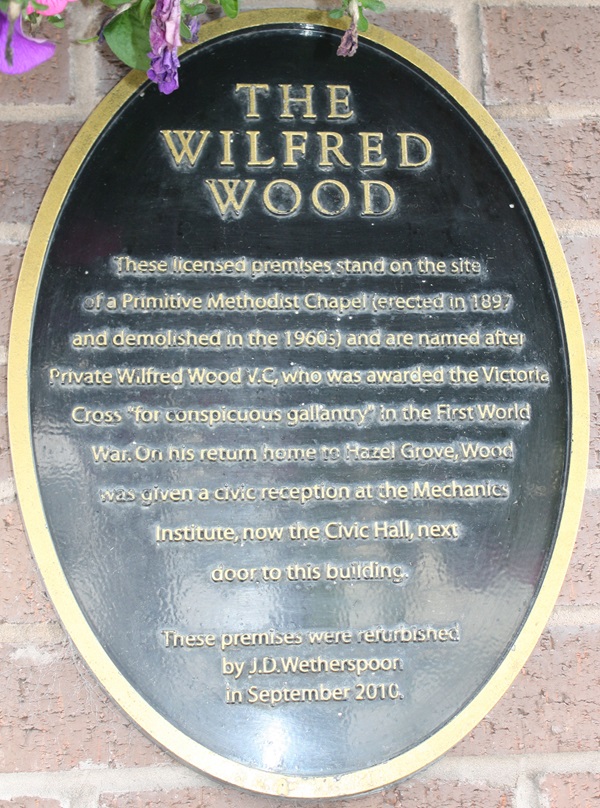
The plaque reads: These licensed premises stand on the site of a Primitive Methodist Chapel (erected in 1897 and demolished in the 1960s) and are named after Private Wilfred Wood V.C, who was awarded the Victoria Cross “for conspicuous gallantry” in the First World War. On his return home to Hazel Grove, Wood was given a civic reception at the Mechanics Institute, now the Civic Hall, next door to the building.
These premises were refurnished by J.D. Wetherspoon in September 2010.
Photographs and text about Wilfred Wood VC.
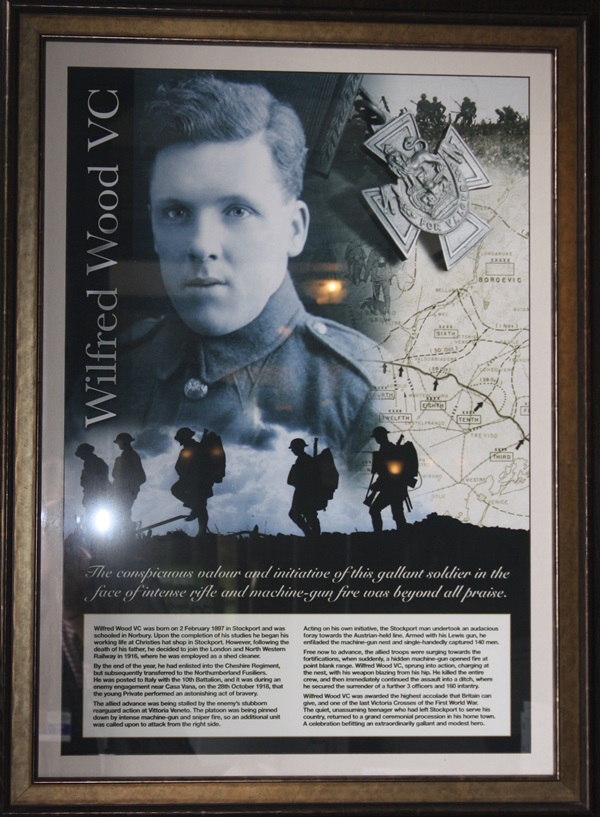
The text reads: The conspicuous valour and initiative of this gallant soldier in the face of intense rifle and machine-gun fire was beyond all praise.
Wilfred Wood VC was born on 2 February 1897 in Stockport and was schooled in Norbury. Upon the completion of his studies he began his working life at Christies hat shop in Stockport. However, following the death of his father, he decided to join the London and North Western Railway in 1916, where he was employed as a shed cleaner.
By the end of the year, he had enlisted into the Cheshire Regiment, but subsequently transferred to the Northumberland Fusiliers. He was posted to Italy with the 10th Battalion, and it was during an enemy engagement near Casa Vana, on the 28 October 1918, that the young Private performed an astonishing act of bravery.
The allied advance was being stalled by the enemy’s stubborn rearguard action at Vittoria Veneto. The platoon was being pinned down by intense machine-gun and sniper fire, so an additional unit was called upon to attack from the right side.
Acting on his own initiative, the Stockport man undertook an audacious foray towards the Austrian-held line. Armed with his Lewis gun, he enfiladed the machine-gun nest and single-handedly captured 140 men.
Free now to advance, the allied troops were surging towards the fortifications, when suddenly, a hidden machine-gun opened fire at point blank range. Wilfred VC, sprang into action, charging at the nest, with his weapon blazing from his hip. He killed the entire crew, and then immediately continued the assault into a ditch, where he secured the surrender of a further 3 officers and 160 infantry.
Wilfred Wood VC was awarded the highest accolade that Britain can give, and one the last Victoria Crosses of the First World War. The quiet, unassuming teenager who had left Stockport to serve his country, returned to a grand ceremonial procession in his home town. A celebration befitting an extraordinary gallant and modest hero.
Photographs and text about Wilfred Wood VC.
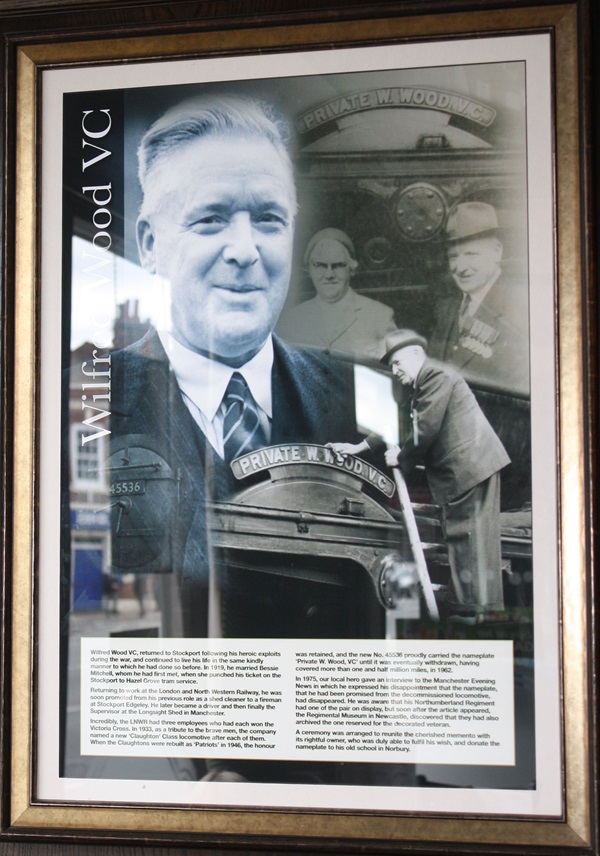
The text reads: Wilfred Wood VC, returned to Stockport following his heroic exploits during the war, and continued to live his life in the same kindly manner to which he had done so before. In 1919, he married Bessie Mitchell, whom he had first met, when she punched his ticket on the Stockport to Hazel Grove tram service.
Returning to work at the London and North Western Railway, he was soon promoted from his previous role as a shed cleaner to a fireman at Stockport Edgeley. He later became a driver and then finally the Supervisor at the Longsight Shed in Manchester.
Incredibly, the LNWR had three employees who had each won the Victoria Cross. In 1933, as a tribute to the brave men, the company named a new ‘Claughton’ class locomotive after each of them. When the Claughtons were rebuilt as ‘Patriots’ in 1946, the honour retained, and the new No. 45536 proudly carried the nameplate ‘Private W.Wood, VC’ until it was eventually withdrawn, having covered more than one and half million miles, 1962.
In 1975, our local hero gave an interview to the Manchester Evening News in which he expressed his disappointment that the nameplate, that he had been promised from the decommissioned locomotive, had disappeared. He was aware that his Northumberland Regiment had one pair on display, but soon after the article appeared, the Regimental Museum in Newcastle, discovered that they had also archived the one reserved for the decorated veteran.
A ceremony was arranged to reunite the cherished memento with its rightful owner, who was duly able to fulfil his wish, and donate the nameplate to his old school in Norbury.
Photographs and text about Wendy Hiller.
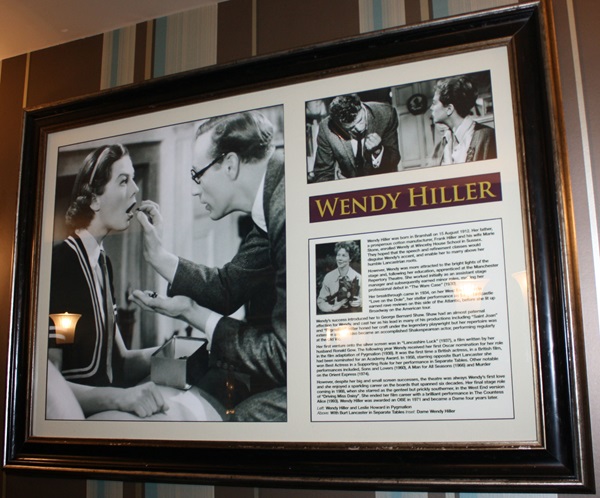
The text reads: Wendy Hiller was born in Bramhall on 15 August 1912. Her father, a prosperous cotton manufacturer, Frank Hiller and his wife Marie Stone, enrolled Wendy at Winceby House School in Sussex. They hoped that the speech and refinement classes would disguise Wendy’s accent, and enable her to marry above her humble Lancastrian roots.
However, Wendy was more attracted to the bright lights of the stage and, following her education, apprenticed at the Manchester Repertory Theatre. She worked initially as an assistant stage manager and subsequently earned minor roles, making her professional debut in “The Ware Case” (1930).
Her breakthrough came in 1934, on her West End debut in “Love on the Dole”, her stellar performance as Sally Hardcastle earned rave reviews on this side of the Atlantic, before she lit up Broadway on the American tour.
Wendy’s success introduced her to George Bernard Shaw. Shaw had an almost paternal affection for Wendy, and cast her as his lead in many of his productions including “Saint Joan” and “Pygmalion”. Hiller honed her craft under the legendary playwright but her repertoire was extensive and she also became an accomplished Shakespearian actor, performing regularly at the Old Vic.
Her first venture onto the silver screen was in “Lancashire Luck” (1937), a film written by her husband Ronald Gow. The following year Wendy received her first Oscar nomination for her role in the film adaption of “Pygmalion” (1938). It was the first time a British actress, in a British film, had been nominated for an Academy Award. In 1958, starring opposite Burt Lancaster she won Best Actress in a Supporting Role for her performance in “Separate Tables”. Other notable performances included, “Sons and Lovers” (1960), “A Man for All Seasons” (1966) and “Murder on the Orient Express” (1974).
However, despite her big and small screen successes, the theatre was always Wendy’s first love and she enjoyed a sparkling career on the boards that spanned six decades. Her final stage role came in 1988, when she starred as the genteel but prickly southerner, in the West End version of “Driving Miss Daisy”. She ended her film career with a brilliant performance in “The Countess Alice” (1993), Wendy Hiller was awarded OBE in 1971 and became a Dame four years later.
Left: Wendy Hiller and Leslie Howard in Pygmalion
Above: With Burt Lancaster in Separate Tables
Inset: Dame Wendy Hiller.
Illustrations and text about Sir Joseph Whitworth.
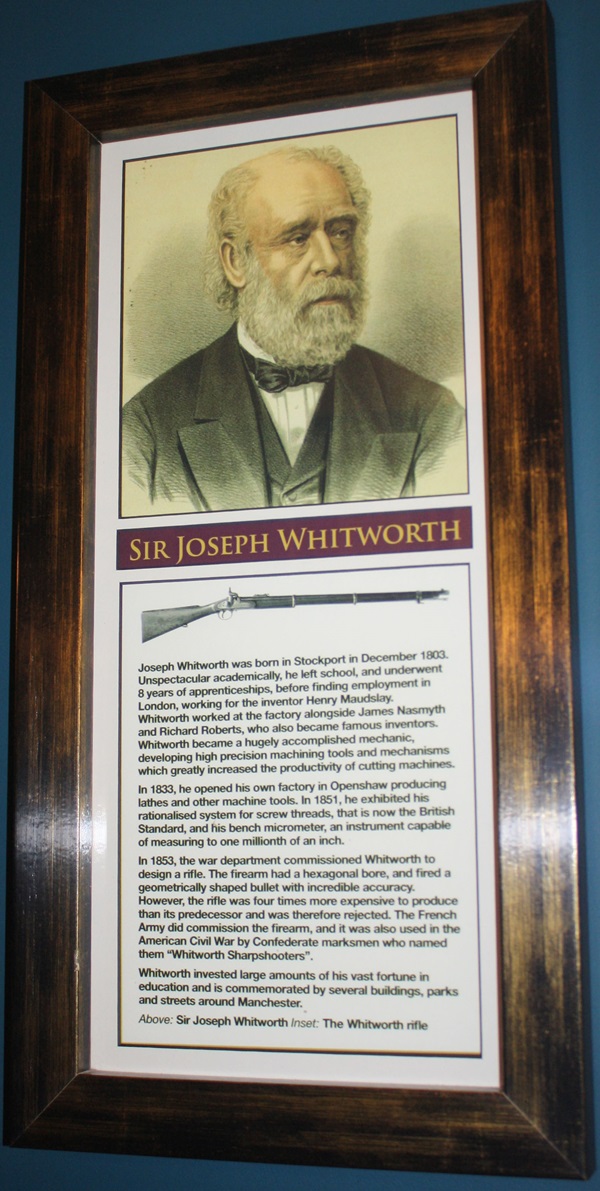
The text reads: Joseph Whitworth was born in Stockport in December 1803. Unspectacular academically, he left school, and underwent 8 years of apprenticeships, before finding employment in London, working for the inventor Henry Maudslay. Whitworth worked at the factory alongside James Nasmyth and Richard Roberts, who also became famous inventors. Whitworth became a hugely accomplished mechanic, developing high precision machining tools and mechanisms which greatly increased the productivity of the cutting machines.
In 1833, he opened his own factory in Openshaw producing lathes and other machine tools. In 1851, he exhibited his rationalised system for screw threads, that is now the British Standard, and his bench micrometre, an instrument capable of measuring to one millionth of an inch.
In 1853, the war department commissioned Whitworth to design a rifle. The firearm had a hexagonal bore, and fired a geometrically shaped bullet with incredible accuracy. However, the rifle was four times more expensive to produce than its predecessor and was therefore rejected. The French Army did commission the firearm, and it was also used in the American Civil War by Confederate marksmen who named them “Whitworth Sharpshooters”.
Whitworth invested large amounts of his vast fortune in education and is commemorated by several buildings, parks and streets around Manchester.
Above: Sir Joseph Whitworth
Inset: The Whitworth rifle.
Photographs and text about Peter Boardman.
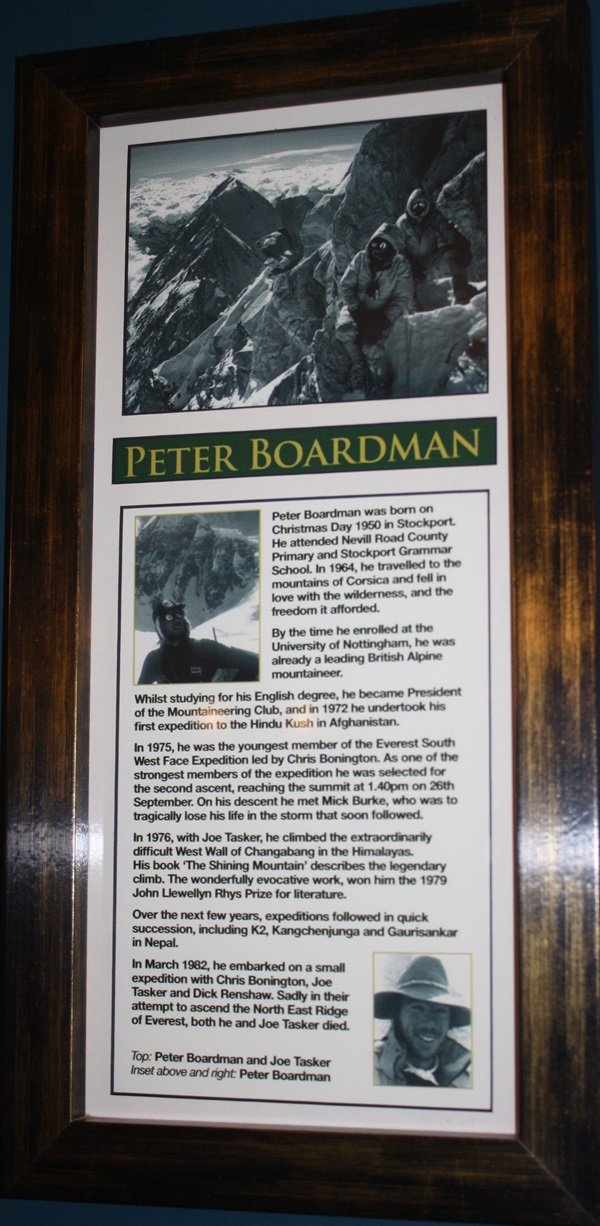
The text reads: Peter Boardman was born on Christmas Day 1950 in Stockport. He attended Nevill Road County Primary and Stockport Grammar School. In 1964, he travelled to the mountains of Corsica and fell in love with the wilderness, and the freedom it afforded.
By the time he enrolled at the University of Nottingham, he was already a leading British Alpine mountaineer.
Whilst studying for his English degree, he became President of the Mountaineering Club, and in 1972 he undertook his first expedition to Hindu Kush in Afghanistan.
In 1975, he was the youngest member of the Everest South West Face Expedition led by Chris Bonington. As one of the strongest members of the expedition he was selected for the second ascent, reaching the summit at 1.40pm on 26th September. On his descent he met Mick Burke, who was to tragically lose his life in the storm that soon followed.
In 1976, with Joe Tasker, he climbed the extraordinarily difficult West Wall of Changabang in the Himalayas. His book ‘The Shining Mountain’ describes the legendary climb. The wonderfully evocative work, won him the 1979 John Llewellyn Rhys Prize for literature.
Over the next few years, expeditions followed in quick succession, including K2, Kangchenjunga and Gaurisankar in Nepal.
In March 1982, he embarked on a small expedition with Chris Bonington, Joe Tasker and Dick Renshaw. Sadly in their attempt to ascend the North East Ridge of Everest, both he and Joe Tasker died.
Top: Peter Boardman and Joe Tasker
Inset above and right: Peter Boardman.
A photograph and text about Fred Perry.
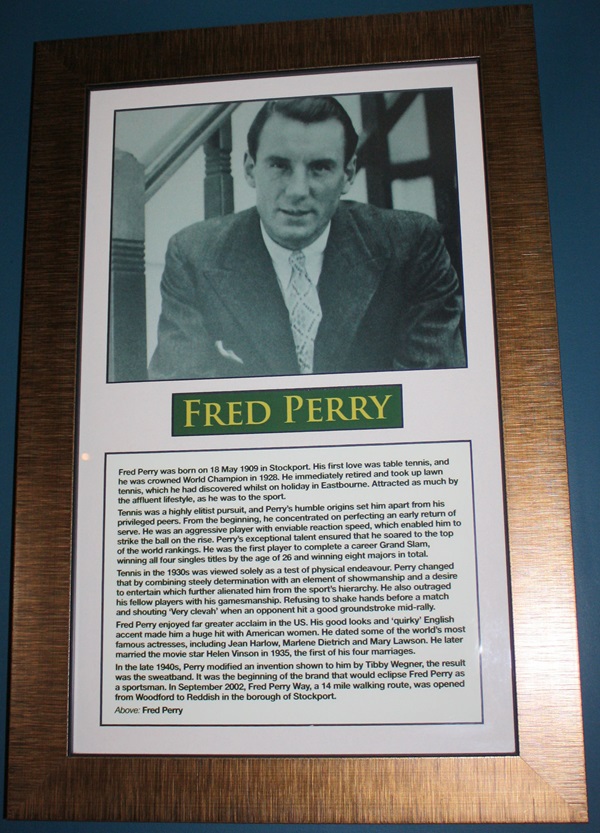
The text reads: Fred Perry was born on 18 May 1909 in Stockport. His first love was table tennis, and he was crowned World Champion in 1928. He immediately retired and took up lawn tennis, which he had discovered whilst on holiday in Eastbourne. Attracted as much by the affluent lifestyle, as he was to the sport.
Tennis was a highly elitist pursuit, and Perry’s humble origins set him apart from his privileged peers. From the beginning, he concentrated on perfecting an early return of serve. He was an aggressive player with enviable reaction speed, which enabled him to strike the ball on the rise. Perry’s exceptional talent ensured that he soared to the top of the world rankings. He was the first player to complete a career Grand Slam, winning all four singles titles by the age of 26 and winning eight majors in total.
Tennis in the 1930s was viewed solely as a test of physical endeavour. Perry changed that by combing steely determination with an element of showmanship and a desire to entertain which further alienated him from the sport’s hierarchy. He also outraged his fellow players with his gamesmanship. Refusing to shake hands before a match and shouting ‘Very clevah’ when an opponent hit a good groundstroke mid-rally.
Fred Perry enjoyed far greater acclaim in the US. His good looks and ‘quirky’ English accent made him a huge hit with American women. He dated some of the world’s most famous actresses, including Jean Harlow, Marlene Dietrich and Mary Lawson. He Later married the movie star Helen Vinson in 1935, the first of his four marriages.
In the late 1940s, Perry modified an invention shown to him by Tibby Wegner, the result was the sweatband. It was the beginning of the brand that would eclipse Fred Perry as a sportsman. In September 2002, Fred Perry Way, a 14 mile walking route, was opened from Woodford to Reddish in the borough of Stockport.
Above: Fred Perry.
A print of Gabrielle Ray – actress, dancer and singer.
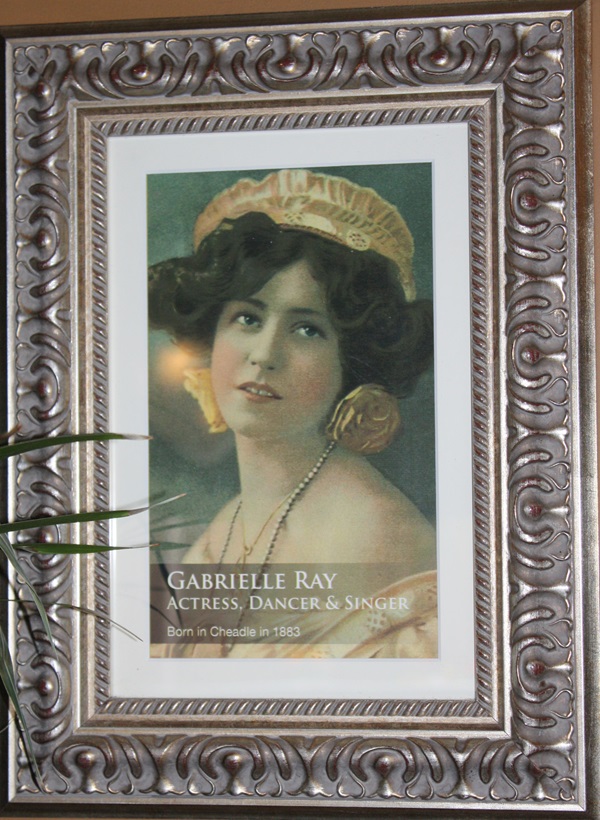
Born in Cheadle in 1883.
A photograph of Allied Bakeries, Bredbury, Stockport.
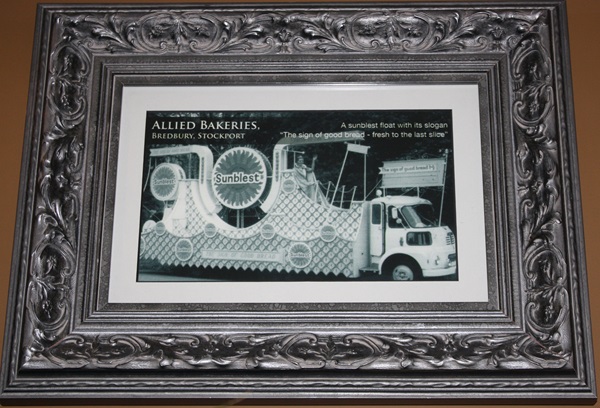
A sunblest float with its slogan “The sign of good bread – fresh to the last slice”.
An illustration of Richard Arden, First Baron Alvanley.
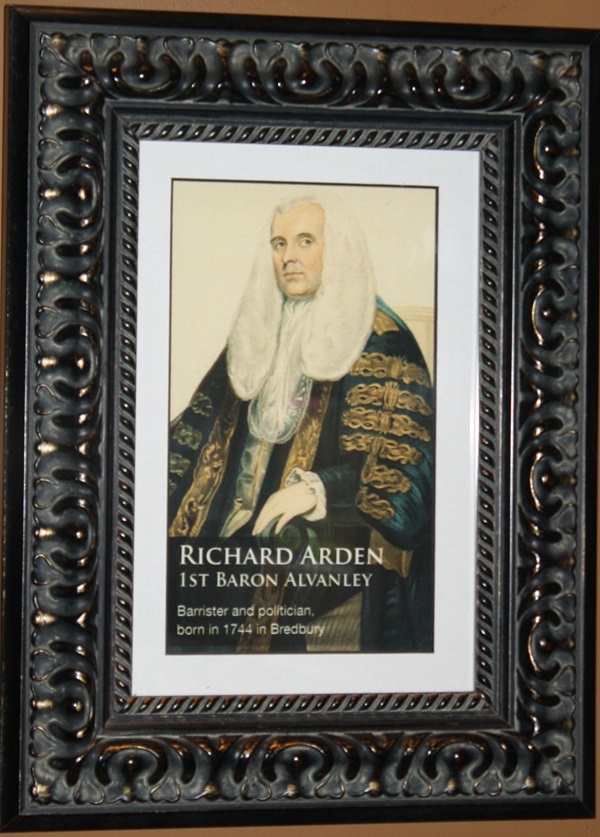
Barrister and politician, born in 1744 in Bredbury.
A photograph of Bredbury Hall, Stockport.
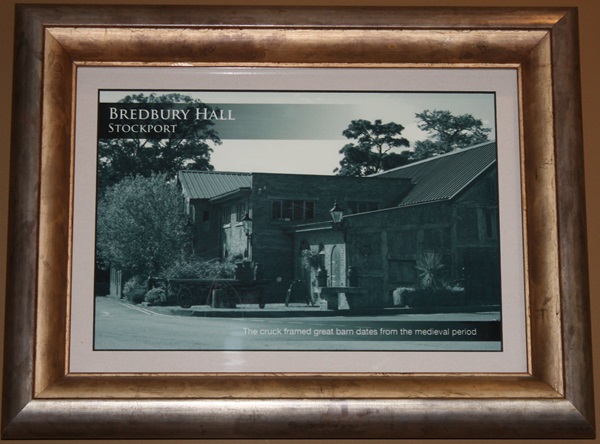
The cruck framed great barn dates from the medieval period.
Photographs of Wellington Mill, Stockport.
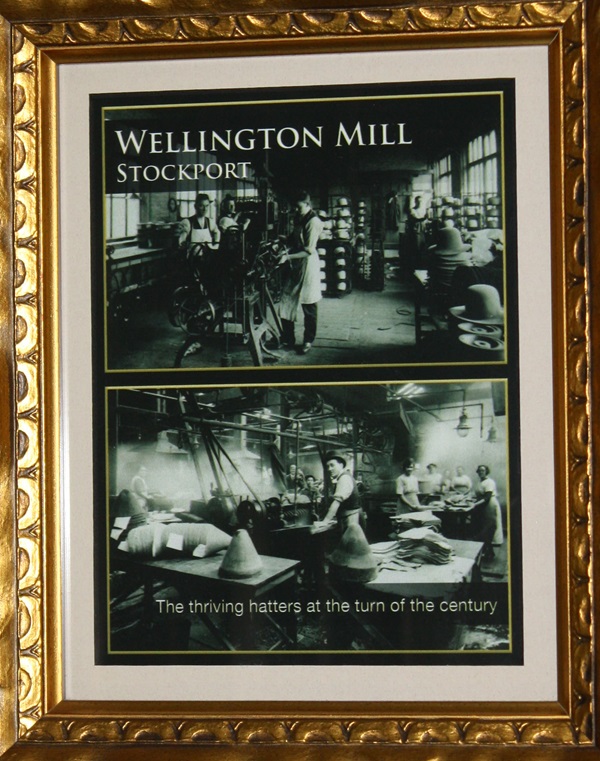
A photograph, painting and text about Air Commodore Dame Felicity Peake DBE.
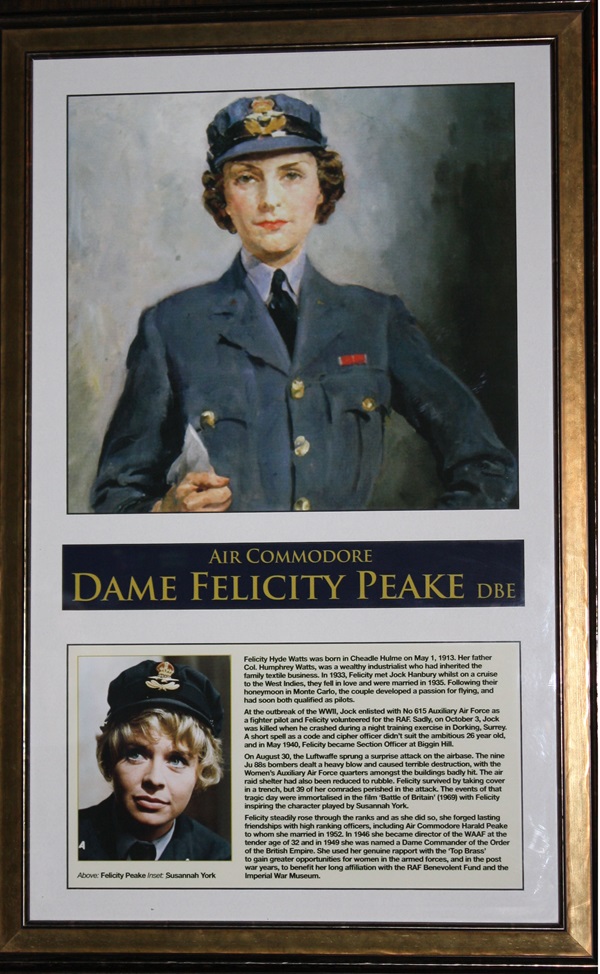
The text reads: Felicity Hyde Watts was born in Cheadle Hulme on May 1, 1913. Her father Col. Humphrey Watts, was a wealthy industrialist who had inherited the family textile business. In 1933, Felicity met Jock Hanbury whilst on a cruise to the West Indies, they fell in love and were married in 1935. Following their honeymoon in Monte Carto, the couple developed a passion for flying, and had soon both qualified as pilots.
At the outbreak of the WWII. Jock enlisted with No 615 Auxiliary Air Force as a fighter pilot and Felicity volunteered for the RAF. Sadly, on October 3. Jock was killed when he crashed during a night training exercise in Dorking. Surrey.
A short spell as a code aid cipher officer didn't suit the ambitious 26 year old, and in May 1940, Felicity became Section Officer at Biggin Hill.
On August 30, the Luftwaffe sprung a surprise attack on the airbase. The nine Ju 88s bombers dealt a heavy blow and caused terrible destruction, with the Women's Auxiliary Air Force quarters amongst the buildings badly hit. The air raid shelter had also been reduced to rubble. Felicity survived by taking cover in a trench, but 39 of her comrades perished in the attack. The events of that tragic day were immortalised in the film ‘Battle of Britain’ (1969) with Felicity inspiring the character played by Susannah York.
Felicity steadily rose through the ranks and as she did so, she forged lasting friendships with high ranking officers, including Air Commodore Harald Peake to whom she married in 1952. In 1946 she was named a Dame Commander of the Order of the British Empire. She used her genuine rapport with the ‘Top Brass’ to gain greater opportunities for women in the armed forces, and in the post war years, to benefit her long affiliation with the RAF Benevolent Fund and the Imperial War Museum.
The 1953 Coronation Medal.
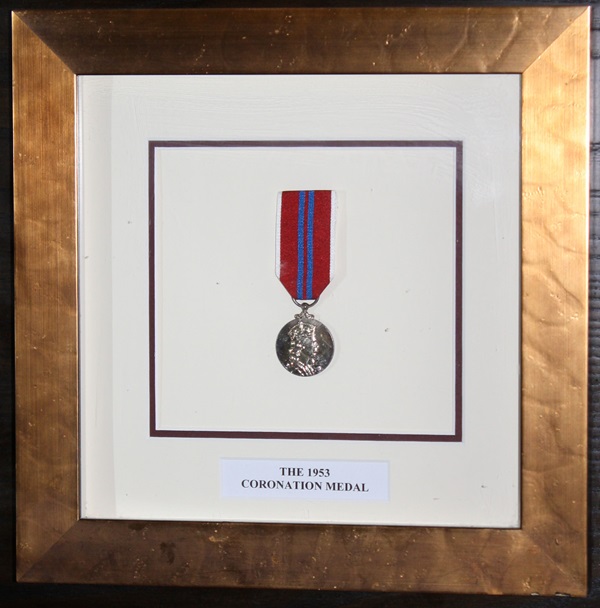
The 1977 Queen’s Silver Jubilee Medal.
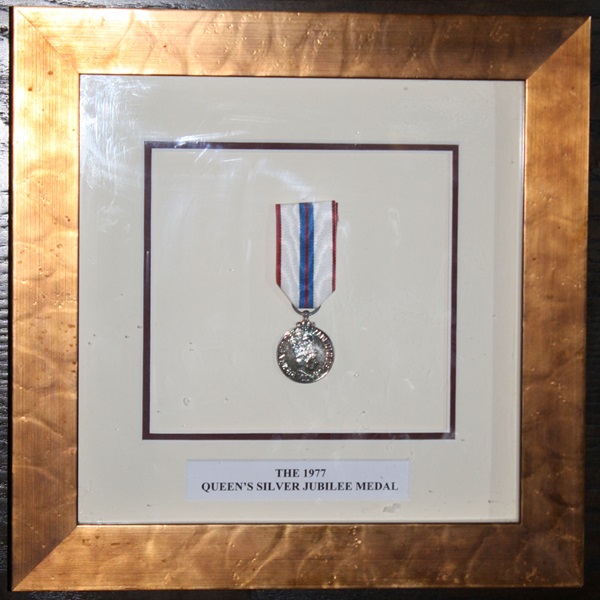
The Defence Medal, 1939-1945.
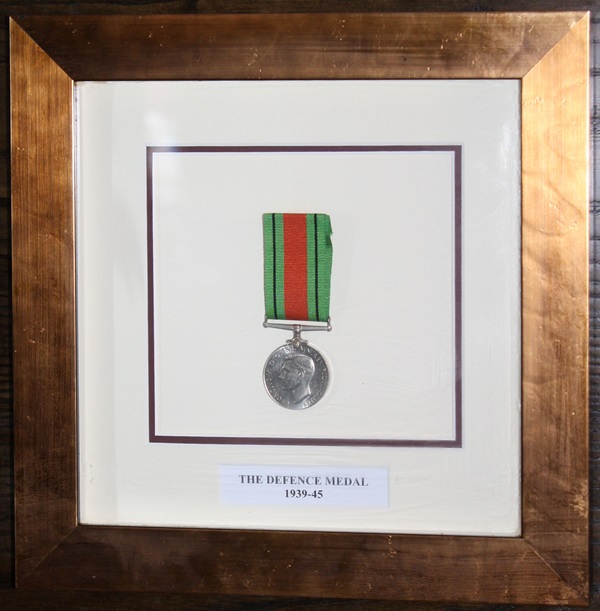
The Allied Victory Medal, 1914-1919.
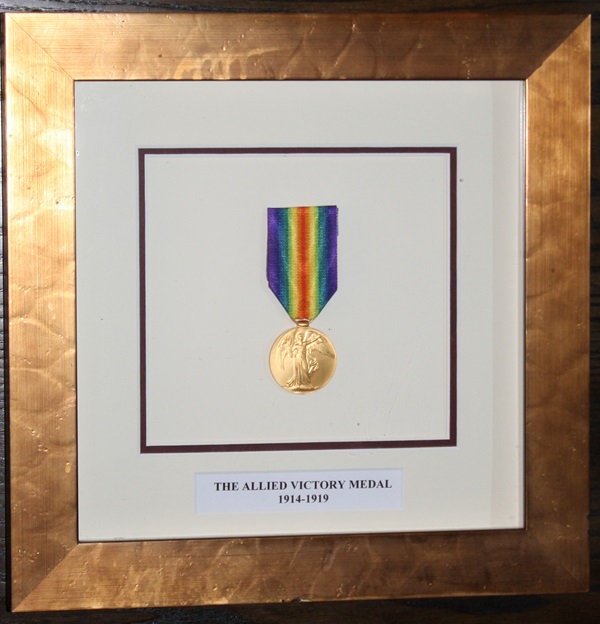
An oil canvas painting entitled Stockport Town Hall, by local artist Alan Knight.
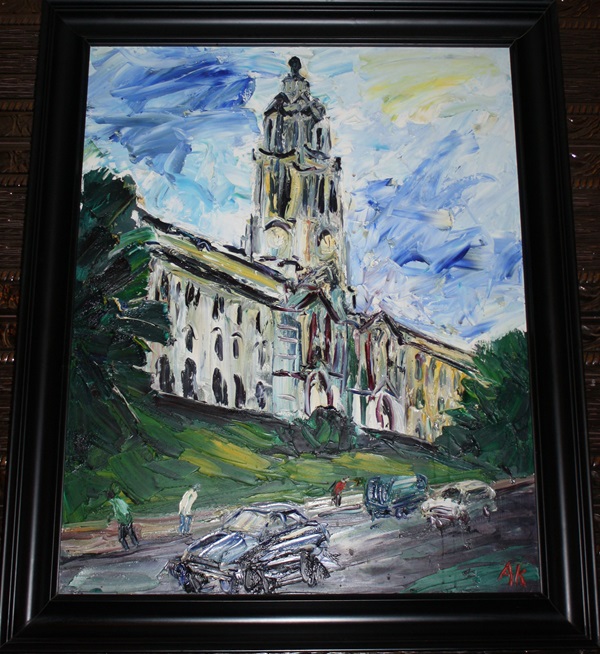
Stockport Town Hall was opened in 1908. It is known locally as the "wedding cake” because of its tiered clock tower made of white limestone. It was designed by Sir Brumwell Thomas who also designed a replica Town Hall for Belfast.
A sculpture entitled A Tribute to ‘Bullock Smithy’, by local blacksmith Luke Lister.

Bullock Smithy was the original name for what is now Hazel Grove. The name came about after Richard Bullock was granted a lease in 1560 to establish a smithy. As the smithy became more established, people started to use the name to refer to the area around the smithy and eventually the whole village.
The smithy supplied and fitted iron shoes for horses and leather shoes for bullocks. It also repaired carts and farming implements.
After being known as Bullock Smithy for 250 years, the name was officially changed at a public meeting in 1836 to Hazel Grove.
External photograph of the building – main entrance.
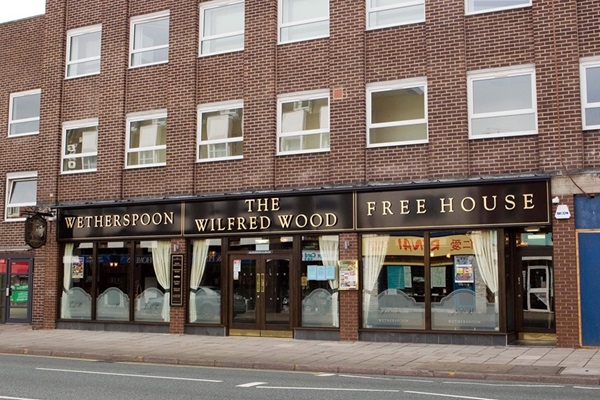
Extract from Wetherspoon News Autumn 2018.
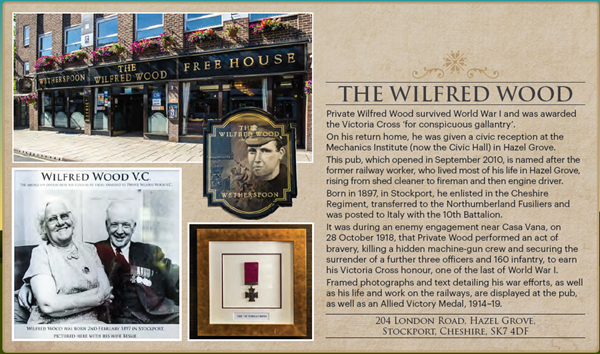
If you have information on the history of this pub, then we’d like you to share it with us. Please e-mail all information to: pubhistories@jdwetherspoon.co.uk